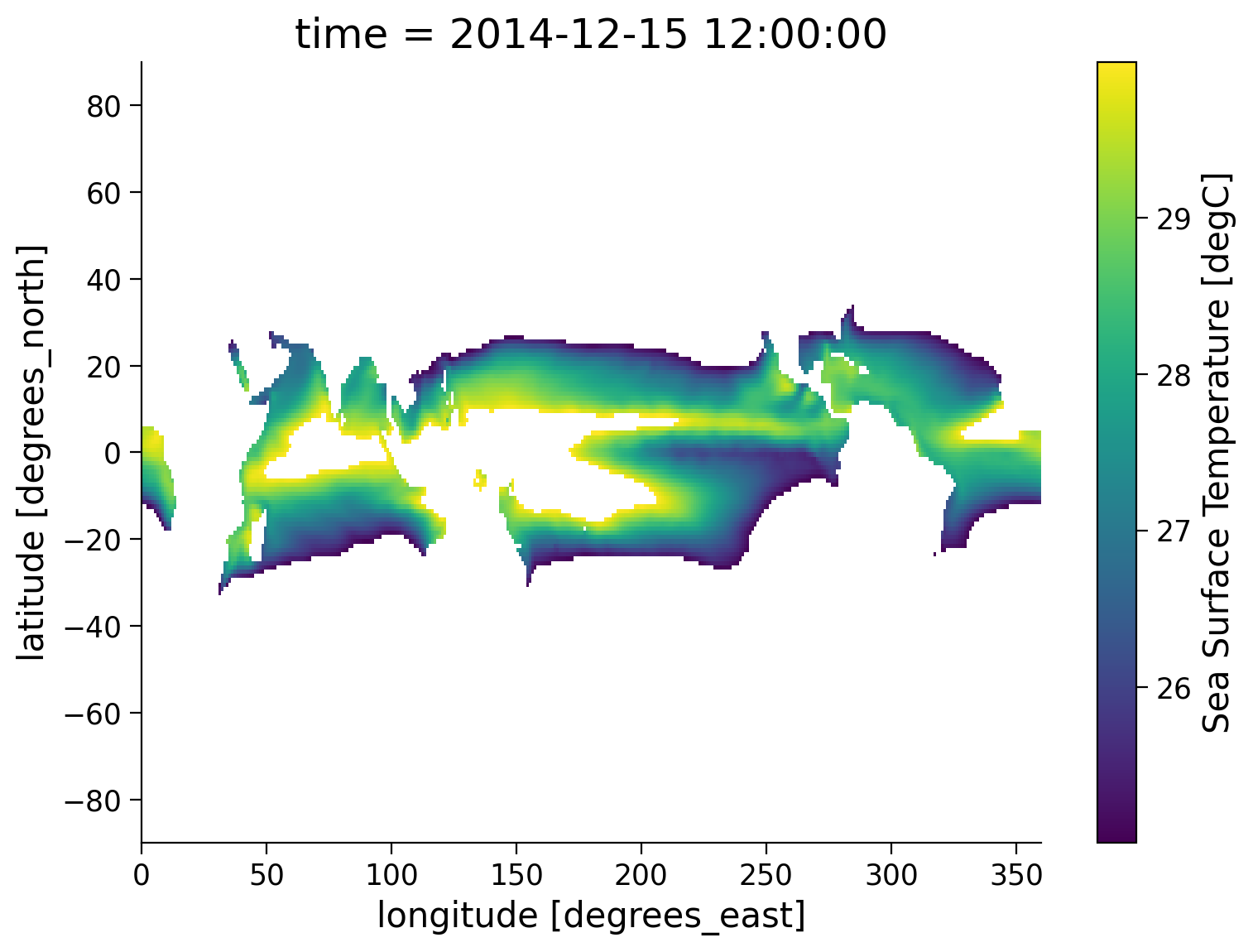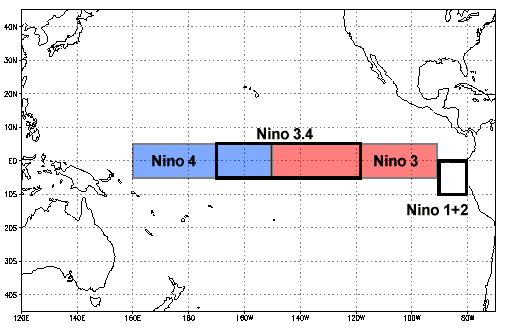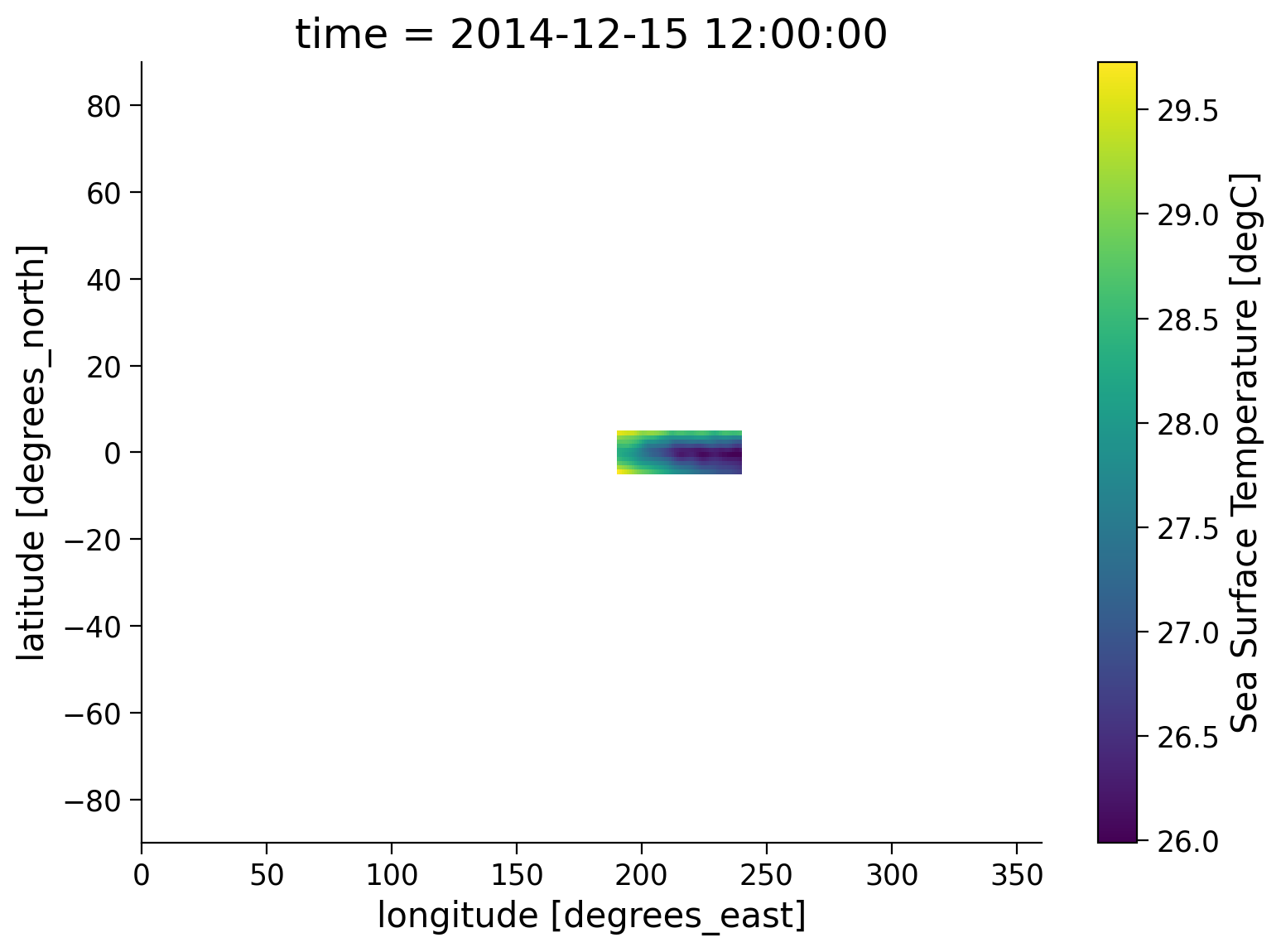Bonus Tutorial 9: Masking with Multiple Conditions#
Week 1, Day 1, Climate System Overview
Content creators: Sloane Garelick, Julia Kent
Content reviewers: Katrina Dobson, Younkap Nina Duplex, Danika Gupta, Maria Gonzalez, Will Gregory, Nahid Hasan, Paul Heubel, Sherry Mi, Beatriz Cosenza Muralles, Jenna Pearson, Agustina Pesce, Chi Zhang, Ohad Zivan
Content editors: Paul Heubel, Jenna Pearson, Chi Zhang, Ohad Zivan
Production editors: Wesley Banfield, Paul Heubel, Jenna Pearson, Konstantine Tsafatinos, Chi Zhang, Ohad Zivan
Our 2024 Sponsors: CMIP, NFDI4Earth
 #
#
Pythia credit: Rose, B. E. J., Kent, J., Tyle, K., Clyne, J., Banihirwe, A., Camron, D., May, R., Grover, M., Ford, R. R., Paul, K., Morley, J., Eroglu, O., Kailyn, L., & Zacharias, A. (2023). Pythia Foundations (Version v2023.05.01) https://zenodo.org/record/8065851
Tutorial Objectives#
Estimated timing of tutorial: 15 minutes
In the previous Tutorial 8, you masked data using one condition (areas where SST was above 0ºC). You can also mask data using multiple conditions. For example, you can mask data from regions outside a certain spatial area by providing constraints on the latitude and longitude.
In this tutorial, you will practice masking data using multiple conditions in order to interpret SST in the tropical Pacific Ocean in the context of the El Niño Southern Oscillation (ENSO).
Setup#
# installations ( uncomment and run this cell ONLY when using google colab or kaggle )
#!pip install pythia_datasets cftime nc-time-axis
# imports
import xarray as xr
from pythia_datasets import DATASETS
import matplotlib.pyplot as plt
/opt/hostedtoolcache/Python/3.9.18/x64/lib/python3.9/site-packages/pythia_datasets/__init__.py:4: UserWarning: pkg_resources is deprecated as an API. See https://setuptools.pypa.io/en/latest/pkg_resources.html. The pkg_resources package is slated for removal as early as 2025-11-30. Refrain from using this package or pin to Setuptools<81.
from pkg_resources import DistributionNotFound, get_distribution
Install and import feedback gadget#
Show code cell source
# @title Install and import feedback gadget
!pip3 install vibecheck datatops --quiet
from vibecheck import DatatopsContentReviewContainer
def content_review(notebook_section: str):
return DatatopsContentReviewContainer(
"", # No text prompt
notebook_section,
{
"url": "https://pmyvdlilci.execute-api.us-east-1.amazonaws.com/klab",
"name": "comptools_4clim",
"user_key": "l5jpxuee",
},
).render()
feedback_prefix = "W1D1_T9"
Figure Settings#
Show code cell source
# @title Figure Settings
import ipywidgets as widgets # interactive display
%config InlineBackend.figure_format = 'retina'
plt.style.use(
"https://raw.githubusercontent.com/neuromatch/climate-course-content/main/cma.mplstyle"
)
Video 1: Past, Present, and Future Climate#
Submit your feedback#
Show code cell source
# @title Submit your feedback
content_review(f"{feedback_prefix}_Past_Present_Future_Climate_Video")
If you want to download the slides: https://osf.io/download/dtgax/
Submit your feedback#
Show code cell source
# @title Submit your feedback
content_review(f"{feedback_prefix}_Past_Present_Future_Climate_Slides")
Section 1: Using .where() with multiple conditions#
First, let’s load the same data that we used in the previous tutorials (monthly sea surface temperature (SST) data from the climate model CESM2):
filepath = DATASETS.fetch("CESM2_sst_data.nc")
ds = xr.open_dataset(filepath)
ds
/opt/hostedtoolcache/Python/3.9.18/x64/lib/python3.9/site-packages/xarray/conventions.py:440: SerializationWarning: variable 'tos' has multiple fill values {1e+20, 1e+20}, decoding all values to NaN.
new_vars[k] = decode_cf_variable(
<xarray.Dataset> Size: 47MB
Dimensions: (time: 180, d2: 2, lat: 180, lon: 360)
Coordinates:
* time (time) object 1kB 2000-01-15 12:00:00 ... 2014-12-15 12:00:00
* lat (lat) float64 1kB -89.5 -88.5 -87.5 -86.5 ... 86.5 87.5 88.5 89.5
* lon (lon) float64 3kB 0.5 1.5 2.5 3.5 4.5 ... 356.5 357.5 358.5 359.5
Dimensions without coordinates: d2
Data variables:
time_bnds (time, d2) object 3kB ...
lat_bnds (lat, d2) float64 3kB ...
lon_bnds (lon, d2) float64 6kB ...
tos (time, lat, lon) float32 47MB ...
Attributes: (12/45)
Conventions: CF-1.7 CMIP-6.2
activity_id: CMIP
branch_method: standard
branch_time_in_child: 674885.0
branch_time_in_parent: 219000.0
case_id: 972
... ...
sub_experiment_id: none
table_id: Omon
tracking_id: hdl:21.14100/2975ffd3-1d7b-47e3-961a-33f212ea4eb2
variable_id: tos
variant_info: CMIP6 20th century experiments (1850-2014) with C...
variant_label: r11i1p1f1The .where() method allows us to mask using multiple conditions. To do this, we need to make sure each conditional expression is enclosed in (). To combine conditions, we use the bit-wise and (&) operator and/or the bit-wise or (|). Let’s use .where() to isolate locations with temperature values greater than 25 and less than 30:
# take the last time step as our data
sample = ds.tos.isel(time=-1)
# just keep data between 25 and 30 degC
sample.where((sample > 25) & (sample < 30)).plot(size=6)
<matplotlib.collections.QuadMesh at 0x7f035116eac0>

Section 2: Using .where() with a Custom Fill Value#
.where() can take a second argument, which, if supplied, defines a fill value for the masked region. Below we fill masked regions with a constant 0:
sample.where((sample > 25) & (sample < 30), 0).plot(size=6)
<matplotlib.collections.QuadMesh at 0x7f035100e940>

Section 3: Using .where() with Specific Coordinates#
We can use coordinates to apply a mask as well. For example, we can use a mask to assess tropical Pacific SST associated with the El Niño Southern Oscillation (ENSO). As we learned in the video, ENSO is a climate phenomenon that originates in the tropical Pacific Ocean but has global impacts on atmospheric circulation, temperature, and precipitation. The two phases of ENSO are El Niño (warmer than average SSTs in the central and eastern tropical Pacific Ocean) and La Niña (cooler than average SSTs in the central and eastern tropical Pacific Ocean). The Niño 3.4 region is an area in the centeral and eastern Pacific Ocean that is often used for determining the phase of ENSO. Below, we will use the latitude and longitude coordinates to mask everywhere outside of the Niño 3.4 region. Note in our data that we are in degrees East, so the values we input for longitude will be shifted compared to the figure below.

# input the conditions for the latitude and longitude values we wish to preserve
sample.where(
(sample.lat < 5) & (sample.lat > -5) & (sample.lon > 190) & (sample.lon < 240)
).plot(size=6)
<matplotlib.collections.QuadMesh at 0x7f0350f007f0>

Now let’s look at a time series of the data from this masked region. Rather than specifying a certain time period, we can mask all areas outside of the Niño 3.4 region and then take the spatial mean to assess changes in Niño 3.4 SST over this time period.
nino = ds.tos.where(
(sample.lat < 5) & (sample.lat > -5) & (sample.lon > 190) & (sample.lon < 240)
)
# create a time series of the spatial mean
nino_mean = nino.mean(dim=["lat", "lon"])
nino_mean
<xarray.DataArray 'tos' (time: 180)> Size: 720B
array([26.038105, 26.504568, 27.12734 , 27.849018, 28.161907, 28.084658,
27.86784 , 27.24528 , 26.758245, 26.700113, 26.857403, 27.123154,
27.308672, 27.583426, 28.183249, 28.757906, 29.154528, 28.922132,
28.53686 , 27.924234, 27.596992, 28.069708, 28.465366, 28.796396,
28.813364, 29.041746, 29.058504, 28.948875, 29.033705, 28.5182 ,
27.470001, 25.894114, 25.304356, 24.778294, 24.657923, 24.829865,
24.784239, 25.087923, 25.951988, 26.456623, 26.913073, 27.061895,
27.022371, 26.912659, 26.674786, 26.8258 , 27.2423 , 27.584587,
27.613594, 27.96198 , 28.397165, 28.84863 , 28.815447, 28.337137,
28.044477, 27.763422, 27.307722, 27.099895, 27.47686 , 27.731833,
27.965302, 28.204346, 28.682114, 28.988297, 29.027813, 28.343401,
27.305414, 26.22925 , 25.649109, 25.174723, 25.474989, 25.517603,
25.692791, 26.534395, 27.39288 , 28.077316, 28.354757, 28.162205,
27.776447, 26.985735, 26.379864, 25.875566, 26.239515, 26.413954,
26.43264 , 26.737282, 27.485762, 27.919657, 28.250576, 28.280407,
27.94568 , 27.163921, 26.539751, 26.662567, 27.129774, 27.367727,
27.42152 , 27.835453, 28.42381 , 29.274023, 29.751787, 29.758398,
29.497955, 28.835 , 28.271896, 28.26253 , 28.642447, 29.135511,
29.249847, 29.375532, 29.413488, 29.641144, 29.266842, 28.057215,
26.326418, 25.036026, 24.046413, 23.709482, 23.932486, 24.301876,
24.36391 , 24.740543, 25.211073, 26.318329, 26.676466, 26.670122,
26.414904, 25.677645, 25.267069, 25.08944 , 25.291477, 25.52739 ,
26.077957, 26.784409, 28.066275, 28.88169 , 29.077969, 29.00119 ,
28.557648, 27.856934, 27.489183, 27.567287, 27.951187, 28.484648,
28.87535 , 29.195566, 29.531723, 29.876328, 30.427414, 30.613188,
30.538868, 29.997889, 29.020626, 28.790129, 29.207897, 29.538794,
29.92879 , 29.776846, 29.73779 , 30.173899, 30.311964, 29.687555,
28.445515, 27.23184 , 26.45716 , 26.063555, 26.201458, 26.389908,
26.35799 , 26.405754, 27.297644, 27.818457, 28.046387, 28.09532 ,
27.83693 , 27.375696, 27.0029 , 27.156403, 27.53574 , 27.549313],
dtype=float32)
Coordinates:
* time (time) object 1kB 2000-01-15 12:00:00 ... 2014-12-15 12:00:00nino_mean.plot()
[<matplotlib.lines.Line2D at 0x7f0350df4f10>]

Questions 3: Climate Connection#
What patterns (e.g. cycles, trends) do you observe in this SST time series for the Niño 3.4 region?
What do you think might be responsible for the patterns you observe? What about any trends?
Notice that we did not use a weighted mean. Do you think the results would be very different if we did weight the mean?
Submit your feedback#
Show code cell source
# @title Submit your feedback
content_review(f"{feedback_prefix}_Questions_3")
Summary#
Similar to NumPy, arithmetic operations are vectorized over a DataArray
Xarray provides aggregation methods like
.sum()and.mean(), with the option to specify which dimension over which the operation will be done.groupby()enables the convenient split-apply-combine workflowThe
.where()method allows for filtering or replacing of data based on one or more provided conditions
Resources#
Code and data for this tutorial is based on existing content from Project Pythia.



